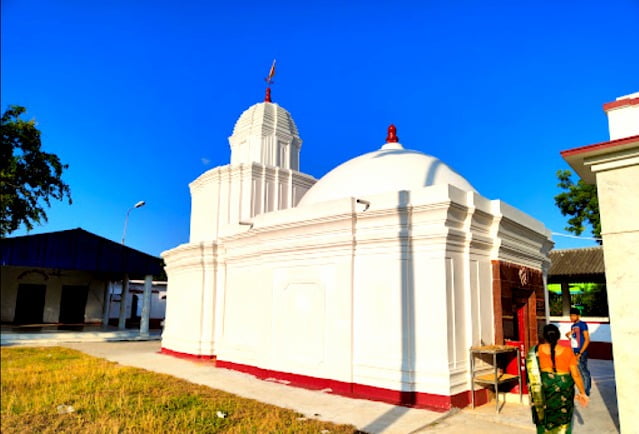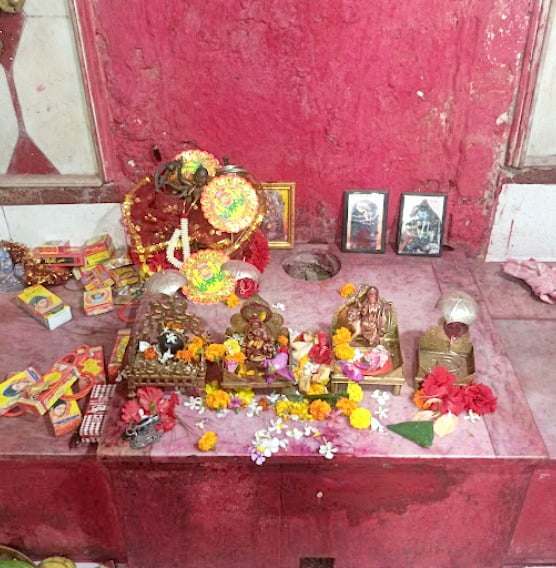Shri Jogadya Shaktipeeth, Kshirgram, West Bengal
Shri Jogadya Shaktipeeth is a Hindu temple dedicated to the goddess Shakti, located in the village of Kshirgram in the Purba Bardhaman district of West Bengal, India. It is one of the 51 Shakti Peethas, or holy sites associated with the Sati, the consort of the Hindu god Shiva.

According to legend, the right great toe of Sati fell here when her body was dismembered by the gods after she immolated herself in protest of her father’s treatment of her husband. The shrine is said to have been built by the king of Kshirgram in the 16th century.
The main temple is a two-tiered structure with a pyramidal roof. The inner sanctum houses a black stone idol of the goddess Jogadya, which is said to have been self-manifested. The shrine also houses a shrine to the god Shiva, known as Kshireshwara or Kshirkantha.
This Shaktipeeth is a popular pilgrimage destination, especially during the annual festival of Mahapuja, which is held in the month of October. Shri Jogadya Shaktipeeth is also known for its annual fair, which is held in the month of February.
Contents
- 1 Interesting facts about Shri Jogadya Shaktipeeth:
- 2 Significance of Shri Jogadya Shaktipeeth:
- 3 Discover More Sacred Sites of West Bengal: Explore These Must-See Temples!
- 4 Miracles of Shri Jogadya Shaktipeeth:
- 5 Temple Timing:
- 6 Tourist spots near Shri Jogadya Shaktipeeth:
- 7 FAQ:
- 7.0.1 Where is Jogadya Shaktipeeth located?
- 7.0.2 Q: What is the significance of Jogadya Shaktipeeth?
- 7.0.3 Q: What is the main deity worshipped at Jogadya Shaktipeeth?
- 7.0.4 Q: What are the best times to visit Jogadya Shaktipeeth?
- 7.0.5 Q: What are the nearest airports and railway stations to Jogadya Shaktipeeth?
- 7.0.6 Q: What are the accommodation facilities available near Jogadya Shaktipeeth?
- 7.0.7 Q: What are the things to do near Jogadya Shaktipeeth?
- 8 How to reach Jogadya Shaktipeeth:
- 9 Google Maps:
Interesting facts about Shri Jogadya Shaktipeeth:
- The temple is mentioned in several tantric texts, including the Kujjika Tantra, the Brihanil Tantra, and the Gandharbha Tantra.
- The shrine was destroyed by the Muslim invaders in the 17th century, but it was rebuilt in the 18th century.
- Shri Jogadya Shaktipeeth is known for its unique architecture, which combines Hindu and Buddhist elements.
- The shrine is home to a large number of sacred fish, which are believed to have healing powers.
- The name “Jogadya” is derived from the Sanskrit words “jog” (union) and “adya” (first). This refers to the belief that the goddess Jogadya is the first manifestation of the divine feminine.
- The temple is also known as the “Kshirika Peetha” (milky pitha), due to the presence of the Kshirdighi pond. The pond is said to be filled with milk, and it is believed that bathing in the pond can cleanse one of sin.
- The shrine is home to a number of sacred objects, including a lingam (aniconic representation of Shiva) that is said to have been brought by Hanuman from the Himalayas.
- This Shaktipeeth is also associated with the Ramayana epic. According to legend, Mahi Ravana, a demon king, kidnapped Rama and Lakshmana and imprisoned them in the underworld. Hanuman rescued the two princes and, while he was there, he also brought back an image of the goddess Bhadrakali, which he installed at Kshirgram.

Significance of Shri Jogadya Shaktipeeth:
Mythological Importance: This Shaktipeeth is believed to be one of the 51 Shaktipeeths mentioned in Hindu mythology. These Shaktipeeths are considered sacred locations where body parts of the goddess Sati (an incarnation of Shakti) fell when Lord Shiva, her consort, carried her charred body after her self-immolation.
Goddess Jogadya: The presiding deity of this Shaktipeeth is Devi Jogadya, also known as Devi Sati. It is believed that her lower teeth (Molar) fell at this location. Devotees visit Shri Jogadya Shaktipeeth to seek blessings and offer prayers to the goddess.
Pilgrimage Destination: Goddess attracts numerous devotees and pilgrims from various parts of India. Many people visit the temple to fulfill their wishes, seek spiritual solace, and receive the blessings of the goddess.
Festivals and Celebrations: The temple celebrates several festivals with great fervor, including Navaratri, Durga Puja, and Kali Puja. These occasions witness a large influx of devotees who participate in various rituals and ceremonies conducted at the shrine.
Architecture: The shrine showcases unique architectural features, reflecting traditional Bengali shrine design. Devotees admire the intricate carvings, sculptures, and religious artwork present within the temple complex.
Discover More Sacred Sites of West Bengal: Explore These Must-See Temples!
Kankalitala Shakti Peeth Temple,
Shree Kiriteswari Shaktipeeth Temple,
Anandamayee Shakti Peeth Temple,
Shree Trishrota Maa Bhramoree Debir Shaktipeeth Temple,
Nandikeshwari Temple | Nandipur Shakti Peeth,
Ujani Shaktipeeth Shri Mangal Chandi Temple,
Vibhash Shakti Peeth | Kapalini Shaktipeeth.
Miracles of Shri Jogadya Shaktipeeth:
The temple is said to have been built by a childless couple who prayed to the goddess for a child. The couple was eventually blessed with a son, and the temple was built in gratitude.
The shrine is said to have been visited by the 15th-century saint Chaitanya Mahaprabhu, who is said to have performed a miracle at the temple. Chaitanya Mahaprabhu is said to have revived a dead child by placing the child’s head on the toe of the goddess.
The shrine is said to have miraculous healing powers. Many devotees come to the temple seeking healing for physical and mental ailments. There are many stories of people who have been cured of their illnesses after praying Shri Jogadya Shaktipeeth.

Temple Timing:
Morning: 6:00 AM to 12:00 PM
Evening: 4:00 PM to 8:00 PM
Shri Jogadya Shaktipeeth is open all 7 days of the week. However, there are some special days when the temple timings are different. For example, on Baisakhi (first day of the Bengali month of Baishakh), the shrine is open from 6:00 AM to 12:00 AM and from 4:00 PM to 10:00 PM.
Tourist spots near Shri Jogadya Shaktipeeth:
Kshirdighi: This is a large pond that is located near the temple. It is said that the right great toe of Sati Devi fell here, and the pond is now a sacred place. You can take a boat ride on the pond, or just relax and enjoy the scenery.
Burdwan Rajbari: This is a palace complex that was built by the Burdwan Raj family in the 18th century. The palace is now a museum, and you can see exhibits on the history of the family and the region.
Katwa: This is a town that is located about 22 kilometers from Kshirgram. It is a charming town with a number of historical buildings, including the Katwa Rajbari, a 17th-century palace.
Mayapur: This is a town that is located about 50 kilometers from Kshirgram. It is a major pilgrimage site for the Gaudiya Vaishnavas, and it is home to the ISKCON temple, one of the largest shrines in the world.
Nadia: This is a district that is located to the south of Kshirgram. It is a fertile region with a number of historical sites, including the Nadia Rajbari, a 16th-century palace.
FAQ:
Where is Jogadya Shaktipeeth located?
A: Shri Jogadya Shaktipeeth is located in the village of Kshirgram, Mongolkot sub-division, Purba Bardhaman district, West Bengal, India. It is about 120 km from Kolkata and 40 km from Bardhaman.
Q: What is the significance of Jogadya Shaktipeeth?
A: Shri Jogadya Shaktipeeth is one of the 51 Shaktipeeths, which are sacred pilgrimage sites dedicated to the Hindu goddess Sati. According to Hindu mythology, the right toe of Sati fell here when her body was dismembered by Lord Shiva after she self-immolated herself in her father’s fire sacrifice.
Q: What is the main deity worshipped at Jogadya Shaktipeeth?
A: The main deity worshipped at Shri Jogadya Shaktipeeth is Goddess Sati, who is worshipped in the form of a Yoni pitha (sacred pedestal). The Yoni pitha is said to be self-manifested and is enshrined in a beautiful temple.
Q: What are the best times to visit Jogadya Shaktipeeth?
A: The best time to visit Shri Jogadya Shaktipeeth is during the Durga Puja festival, which is celebrated in the month of September-October. The temple is also crowded during other festivals such as Navratri, Diwali, and Makar Sankranti.
Q: What are the nearest airports and railway stations to Jogadya Shaktipeeth?
A: The nearest airport to Shri Jogadya Shaktipeeth is Netaji Subhas Chandra Bose International Airport in Kolkata, which is about 120 km away. The nearest railway station is Katwa Railway Station, which is about 40 km away.
Q: What are the accommodation facilities available near Jogadya Shaktipeeth?
A: There are a number of hotels and guesthouses available near Shri Jogadya Shaktipeeth. The temple also has a dharamshala (pilgrim guesthouse) where devotees can stay at a nominal charge.
Q: What are the things to do near Jogadya Shaktipeeth?
A: Apart from visiting the temple, devotees can also visit the following places near Shri Jogadya Shaktipeeth:
- Khirgram Dighi (pond): This is a sacred pond where the right toe of Sati is said to have fallen.
- Khirgram Rajbari (palace): This is a beautiful palace built by the Debi Chowdhurani family in the 18th century.
- Ketugram Shaktipeeth: This is another Shaktipeeth located about 20 km from Jogadya Shaktipeeth.
- Tarapith Shaktipeeth: This is one of the most famous Shaktipeeths in India and is located about 60 km from Jogadya Shaktipeeth.
How to reach Jogadya Shaktipeeth:
By car:
The distance between Hyderabad and Kshirgram is approximately 1,547 kilometers. The fastest route is via NH 65 and NH 16. The total driving time is approximately 30 hours.
By Air:
The nearest airport to Shri Jogadya Shaktipeeth, Kshirgram is Kazi Nazrul Islam Airport (IATA: CCU, ICAO: VEB). It is located in Dum Dum, Kolkata, West Bengal, India, about 50 kilometers (31 mi) from Kshirgram.
By Train:
The nearest railway station to Kshirgram is Kaichar Railway Station. There are direct trains from Hyderabad to Kaichar Railway Station. The train journey takes approximately 15 hours. From Kaichar Railway Station, you can take a rickshaw or bus to reach Kshirgram.
By Bus:
There are direct buses from Hyderabad to Kshirgram. The bus journey takes approximately 20 hours. The buses depart from the Hyderabad Intercity Bus Terminal.
Once you reach Kshirgram, you can take a rickshaw or taxi to reach Shri Jogadya Shaktipeeth. The temple is located approximately 4 kilometers from the Kshirgram Bus Stand.
Here are the directions to reach Jogadya Shaktipeeth from Kshirgram Bus Stand:
From the bus stand, head north on Kshirgram Main Road.
Turn left onto Jogadya Shaktipeeth Road.
The temple will be on your right.
